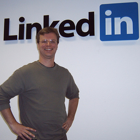Connecting Professionals: The LinkedIn Journey from Idea to Industry Leader

Company profile
Company business details
Motivation to build the product
The founders were motivated by the need to create a platform that would help professionals connect and network more effectively. They recognized that traditional networking methods were often limited and sought to leverage the internet to create a more accessible and efficient way for professionals to build relationships and advance their careers.Problem that their product solves
LinkedIn solves the problem of professional networking by providing a platform where individuals can connect with others in their industry, showcase their skills, and find job opportunities. The end users are professionals looking to expand their networks, find jobs, or collaborate with others, making this solution crucial for career advancement and business growth.Their unfair advantage
LinkedIn's unfair advantage lies in its vast user base and established brand recognition as the leading professional networking platform, which creates a network effect that attracts more users and businesses.Strategies
Launch Stage
Overcoming Social Taboo
In 2006, Reid Hoffman recognized that many professionals viewed putting their resumes online as a sign of desperation. To combat this perception, he focused on changing the narrative around LinkedIn, promoting it as a platform for professional networking rather than job searching. This involved creating a user-friendly interface and emphasizing the benefits of having an online professional presence, which ultimately helped normalize the idea of online resumes.
Initial User Invitations
In the launch stage of LinkedIn, Konstantin Guericke and his co-founders invited 350 of their most important contacts to join the platform. This initial group was crucial as it helped to create a trusted network from the outset. By the end of the first month, this strategy led to a rapid increase in membership, growing from 350 to 4,500 users. This approach not only leveraged their existing relationships but also encouraged those initial users to invite their own contacts, creating a snowball effect of growth.
Focus on Professional Utility
During the launch of LinkedIn, the founders made a conscious decision to differentiate their platform from other social networks by emphasizing its utility for professionals rather than entertainment. They intentionally designed the site to be useful, ensuring that it served as a necessary tool for business networking. This focus on utility helped to attract a user base that was serious about leveraging the platform for professional growth, which was a key factor in its early adoption.
Growth Stage
Leveraging PR for Credibility
Reid emphasized the importance of public relations in building LinkedIn's credibility. He understood that getting featured in reputable media outlets would help establish trust with potential users. By securing coverage in influential publications and podcasts, LinkedIn was able to reach a wider audience and attract new users who might have been skeptical about the platform.
User-Centric Feature Development
Reid and his team focused on developing features that directly addressed user needs. For instance, they introduced recommendations, allowing users to endorse each other's skills. This feature not only added value to the user experience but also encouraged more professionals to join the platform, as they could see the benefits of having their skills recognized by peers.
Learn more about LinkedIn

LinkedIn founder Reid Hoffman talks about how he got started | Scale a Business | Venture Voice




